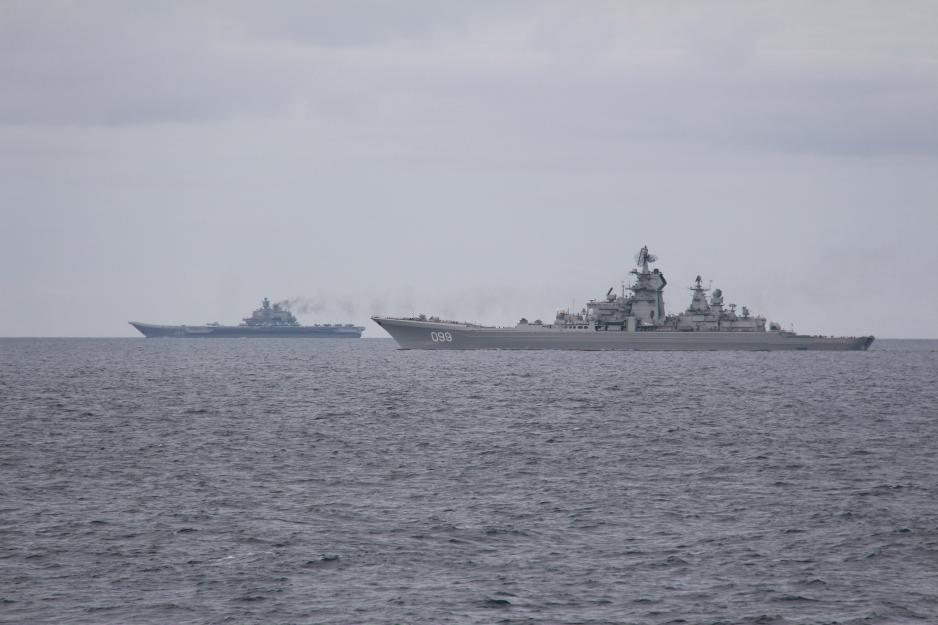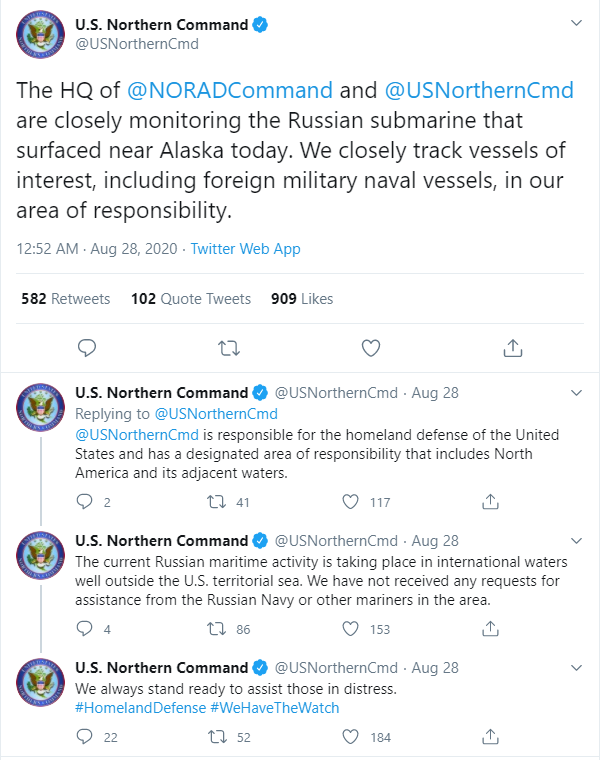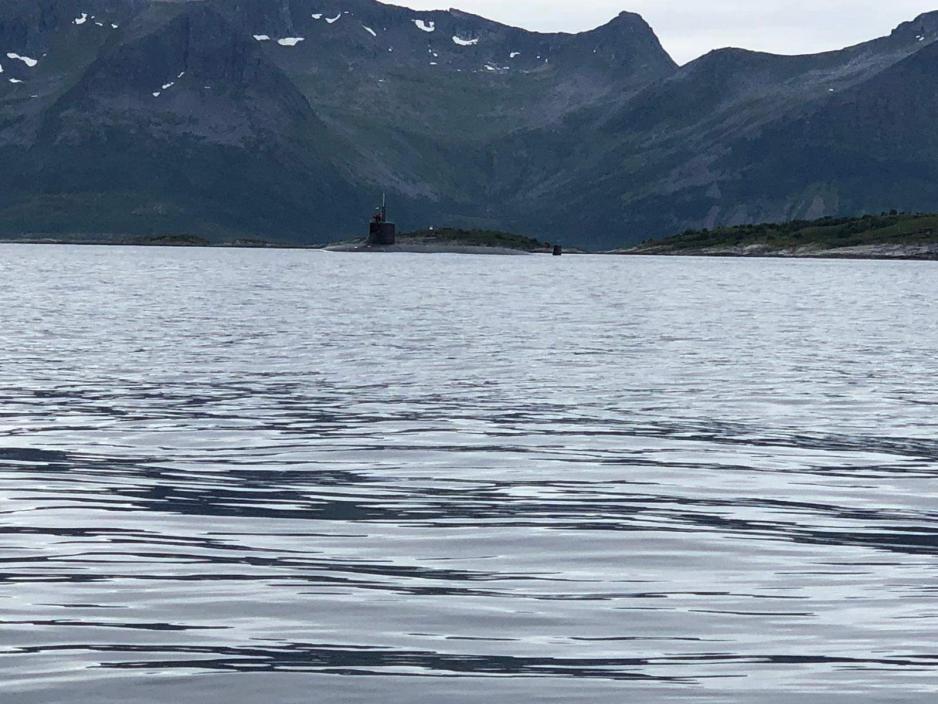“The Natural Protection of Russia’s Vulnerable Flank Towards the USA is About to Melt”

Russian aircraft carriers and escort vessels sailing along the Norwegian coast. The Pacific Fleet also recently conducted large-scale exercises off the coast of Alaska. Researcher Ina Holst-Pedersen Kvam at the Royal Norwegian Naval Academy at The Norwegian Defense University College says the exercise is mainly of a defensive nature. (Photo: Norwegian Armed Forces)
The Russian navy recently conducted a major exercise near Alaska. Researcher Ina Holst-Pedersen Kvam at the Royal Norwegian Naval Academy says the Russian Pacific Fleet is now exercising in new locations and with a magnitude not seen for a long time.
The recent exercises off the coast of Alaska are the largest Russian war games in this area since Soviet times, according to Associated Press (AP).
More than 50 war ships and some 40 planes participated in the exercise in the Bering Sea, according to AP, quoting Russia’s Marine Chief, Admiral Nikolay Yemenov.
Yemenov says the exercise is part of Russia’s effort to increase its presence in the Arctic region and protect access to the country’s economic resources.
According to the U.S. Northern Command, the exercise took place in international waters, well away from American territory.
Need for increased presence
Researcher Ina Holst-Pedersen Kvam the Royal Norwegian Naval Academy, part of the Norwegian Defense University College, says to High North News that there are several reasons why the Russian Pacific Fleet is now exercising in the Bering Sea, in areas where they have not exercised before and with a larger force than seen in a long time.
It has to do with, amongst others, the fact that the sea warfare modernization in Russia is beginning to show results.
“The stronger the Russian navy becomes, the more it will exercise its practical skills and its activities will extend. This is normal for a great power”, Kvam points out.
It further has to do with protecting access to the country’s vast economic resource base in the region as well as exerting control over the Northeast Passage. It is in particular important for Russia to secure the freedom of maneuvering for the Pacific Fleet’s strategic submarines with nuclear arms (SSBN), which is the main priority of the Russian General Staff.
“The fact that the ice is melting in the Arctic reinforces both interest areas and in Russian thinking therefore also the need for increased military presence in the Arctic region.”
Kvam says the melting basically leads the Russian flank towards the USA to become more vulnerable.
According to the researcher, Russian military planning in this region has primarily been concerned with air defense, as the biggest threats over the North Pole has come from American planes. Now, however, with the ice melting, vulnerability increases towards other threats that can come from the ocean space.
“The natural protection of Russia’s vulnerable flank towards the USA provided by sea ice is about to melt away. The exercise is thus mainly of a defensive nature.”
Submarine in surface position
Kvam says that even though there is nothing dramatic about the exercise in and of itself, the most striking aspect of it is that a Russian submarine surfaced off the coast of Alaska.
During the exercise. The US Northern Command announced that it and the North American Aerospace Defense Command (NORAD) was monitoring a Russian submarine that surfaced near Alaska.
In a conversation with High North News on Tuesday, NORAD/NORTHCOM referred to its own Twitter announcement.

The US Northern Command tweeted that it had not received any request for assistance from the Russian navy. (Photo: Screen shot)
Kvam says it is likely that the Russian submarine is Omsk, an Oscar II-class nuclear attack submarine, which also participated in the exercise.
According to the military researcher, such submarines’ area of responsibility is likely to be to operate advanced so as to attack the opponent’s forces in their home ports in surprise attack in the case of a potential conflict.
The incident took place in the wake of an American attack submarine surfacing just outside Tromsø, Norway recently.
The Pacific Ocean-based American attack submarine USS Seawolf was in the vicinity of Tromsø, Norway on 21 August for a stop related to personnel change, according to a press announcement from the USA’s Sixth Fleet.
The USA’s Sixth Fleet operates as a part of the United States naval Forces Europe-Africa.
“USS Seawolf’s deployment from Bangor, Washington, to the U.S. 6th Fleet demonstrates the Submarine Force’s global reach and commitment to provide persistent and clandestine undersea forces worldwide to execute our unique missions with unrivaled readiness,” said Vice Adm. Daryl Caudle, Commander, Submarine Forces, in the press announcement.
Can the two submarine incidents be related?
“It is possible that the Russian submarine chose to reveal its position in order to demonstrate its capacity to maneuver relatively close to an opponent’s territorial borders, not unlike what other Russian submarines have done previously, in particular off the east coast of the USA, where the USA has its largest marine base”, says Kvam.
“In such a perspective, it is possible that the press coverage of the USS Seawolf near Tromsø may have led to a need for a similar stunt demonstrating similar Russian capacity, even though one may safely assume that the Kremlin is well familiar with the fact that American and other allied nuclear attack submarines have operated advanced in the Barents Sea for a long time already”, she adds.

The USS Seawolf is currently deployed at the American Sixth Fleet’s operational area in order to support regional allied and partners as well as the USA’s national security interests in Europe and Africa. (Photo: U.S. Navy)
“Superpowers signaling”
Senior Vice President Heather Conly at the Center for Strategic and International Studies (CSIS) points out to Alaska Public that there has been an increase in American maritime and air activity in the Barents Sea, and that Russia and the USA are “signaling to each other” about the strategic and military importance of the Arctic.
Amongst others, American and British warships sailed the Barents Sea together last May to conduct maritime security operations.
Kvam argues that from an isolated point of view, it is difficult to point at one single incident that has provoked the Russian exercise in the Bering Sea, yet to Russia, it is provoking that there is increased American presence in Russia’s back yard.
“That is because American capacities to power projection in Russian threat perceptions posses the ability to neutralize Russia’s strategic submarines and thus also Russian nuclear second-strike capacity.”
The American vessels exercising in the Barents Sea last May were amongst others equipped with such long-distance precision weapons, she says.
“From this point of view, the American Freedom of Navigation Operations (FONOP) in the area, like the recent one in the Barents Sea, may from a best-case scenario contribute to increasing tension and may in a worst-case scenario potentially lead to an unintended incident.”
This article was originally published in Norwegian and has been translated by HNN's Elisabeth Bergquist.


